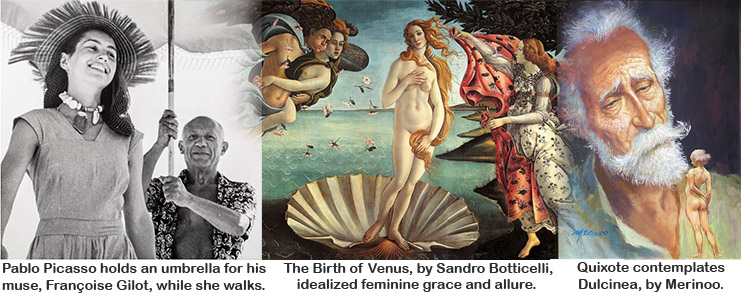
What is Creativity, Really?
In Greek mythology, the Muses were nine goddesses associated with the arts, sciences, and memory. They were considered the source of inspiration for artists, thinkers, poets, dancers, musicians, and philosophers. They were also seen as the goddesses of knowledge, embodying the wisdom and creative power found in poetry, songs, and myths.
This is the point: a muse is never an actual woman.
When a flesh-and-blood woman becomes a man’s muse, she becomes for him the symbol of something deeper, richer, wiser, and more mysteriously transcendent than any mortal woman could ever be.
A muse is a point of access that puts a man in touch with his feminine side while allowing him to pretend that he does not have a feminine side.
A muse is essentially the Jungian anima, the perfect woman who exists only in the imagination of a man.
Just now, my own muse whispered, “The reader will want to ask you, ‘What is a woman’s muse?'”
“What shall I tell them?”
“Tell them to ask a woman,” she said.
In his book, The Magic Synthesis, Silvano Arieti writes,
“Creative products are always shiny and new; the creative process is ancient and unchanging.”
Psychology Today begins their praise of Arieti with this paragraph:
“Silvano Arieti’s book Interpretation of Schizophrenia was awarded the 1975 U.S. National Book Award in the Science category. More than 40 years later, it remains the most significant contribution to the psychological understanding of schizophrenia since Kraepelin and Bleuler. Contemporary psychiatrists and psychotherapists would be wise to review Arieti’s vast contributions to the field.”
Silvano Arieti (1914–1981) was among the world’s foremost authorities on schizophrenia. He wrote an award-winning book about it. The other book he wrote was about creativity.
Coincidence? Perhaps. But it seems to me that creativity might be a mild form of schizophrenia. A marvelous blend of rational with irrational, sophisticated with primitive, conscious with subconscious, in a wild and spontaneous act employed by artists, thinkers, poets, dancers, musicians, and philosophers.
But perhaps I am wrong.
Roy H. Williams
PS – For those of you who believe that I have mischaracterized the anima, I refer you to Roger Woolfe of Wentworth Research, who said, “It is better to be slightly wrong and totally clear than totally right and slightly unclear.”